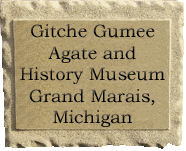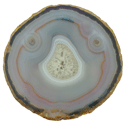MINERAL OF THE MONTH
Spring 2011 - Petrified Wood
Petrified Wood can be thought of as a type of fossil. Fossils are formed from a petrification process, which is a geology term describing the method by which organic living material is converted into stone. Usually, this happens when the organic remains are buried in lava or sediments before they can decay. Petrification can take place in two related ways: replacement and permineralization. Replacement occurs when water dissolves the original hard parts and replaces them with mineral matter. The most common replacement minerals are calcite, silica, pyrite, and hematite. When the original organism is replaced quickly, the fossil usually loses the detailed structure, leaving behind just the original shape. Permineralization occurs when ground water carrying dissolved minerals infiltrates the microscopic pores. The minerals in this case replace the detail of the original organism.
The most famous example of petrification is the Petrified Forest in northern Arizona. However, this is not the only area known for petrified wood since it is also found in nearly every state and in many foreign countries. It is not known for certain who the first Europeans were to see the great display of petrified wood in Arizona. It was probably Spanish explorers during their expeditions in the 1500s. The earliest written record, however, dates from 1851 when an army officer mentioned petrified wood in a report.
At one time the northeast part of Arizona was lowland with numerous rivers and streams. In the basin there was a lush forest with conifer trees up to nine feet in diameter and over 200 feet tall. During the Triassic Period (200 to 250 million years ago), the area that is now Arizona was located near the equator. At that time, all of the continents had combined to form one super-continent called Pangea. Over time, trees in the area died. Rivers deposited the deceased trees in their flood plains or buried them in streambeds. Most of the trees decomposed, but a few were buried so deep that there was not enough oxygen to allow decay. To the west of this area were massive volcanoes that spewed ash into the atmosphere. Wind currents carried the ash and deposited it with the silt that buried the trees. Ground water dissolved silica from the ash and carried it into the buried logs. Over time, the silica in solution either replaced cell walls, crystallizing as quartz, or deposited in the air spaces within the wood tissue. This petrification process explains how cell structure, annual rings, and other features of the original trees were preserved.
As the petrification process continued, other minerals combined with quartz to create the brilliant rainbow of colors often found in petrified wood. In some cases minerals infiltrated later during the millions of years of burial as a secondary deposit in the cracks, checks, or other openings in the petrified or partially petrified wood. Iron oxides produced the great variety of shades of red, brown, and yellow. The black color was probably due to manganese oxide or carbon.
At first, the now petrified trees remained buried under 3,000 feet of sediment. However, around 60 million years ago this area was uplifted along with the Rocky Mountains. With the uplifting came erosion from streams and rivers that removed the overburden layers, exposing the petrified trees.
Some scientists classify petrified wood as agate; others do not. The determination comes down to two issues. First, the type of quartz needs to be identified. In some cases, most of the quartz in petrified wood is macrocrystalline, although there may also be some microcrystalline replacement. For those specimens that contain mostly microcrystalline crystals, the second issue is whether petrification was a replacement process, or whether it may have involved an agatization process. If the wood tissue was directly replaced by silica so that the wood fibers defined the structure, then petrified wood is not agate. If, on the other hand, each of the individual pore spaces self-organized and filled independently, thus creating individual agatized pockets, you could then classify petrified wood as a colony of agates. Depending on the specimen, there could be some of both structures.
Mineral of the Month Archives
May 2007: Rainbow Fluorite
June 2007: Lake Superior Michipicoten Agate
July 2007: Labadorite
August 2007: Rain Flower Agate
Fall 2007: Malachite
December 2007: Nepheline Syenite
January 2008: Native Copper
February 2008: Amazonite
March 2008: Lake Superior Agate
April 2008: Shadow Agate
May 2008: Apohpylite
June 2008: Ocean Jasper
Summer 2008: Marra Mamba Tiger's Eye
September 2008: Mohawkite
October 2008: Mexican opal
November 2008: Prehnite
December 2008: Picture Jasper
January 2009: Sea Shell Jasper
February 2009: Polychrome Jasper
March 2009: Selenite Desert Rose
Spring 2009: Coyamito Agate
July 2009: Obsidian Needles
August 2009: Goethite
September 2009: Banded Iron Formation
Fall 2009: Fairburn Agate
March 2010: Fossilized Dinosaur Bone
April/May: 2010 Kentucky Agate
June 2010: Nantan Meteorite
July 2010: Mookaite Jasper
Aug/Sept 2010: Polyhedroid Agate
Fall 2010: Ammonite Fossil
September 2011: Petoskey Stones
Spring 2011: Petrfied Wood
Winter 2011: Argentina Condor Agate
January 2012: Mary Ellen Jasper
March 2012: Mexican Crazy Lace Agate
June 2012: Moqui Marbles
September 2012: Chlorastrolite Greenstone
March 2013: Jacobsville Sandstone
August 2013: Unakite
November 2013: Skip-an-Atom Agate
April 2014: Tiger's Eye
September 2014: Black Corundum
February 2015: Condor Agate
June 2015: Petoskey Stone
November 2015: Slag
June 2016: Lake Superior Copper Replacement Agates
March 2017: Chert
July 2017: Kona Dolomite
December 2017: Septarian Nodule
Copyright All rights reserved.
Gitche Gumee Museum.
E21739 Brazel Street
Grand Marais, Michigan 49839









